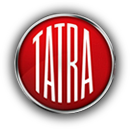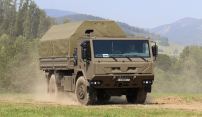- About the Company
TATRA today
- Company profile
- ET-link
- Company bodies and Organisation Chart
- Quality Management
- TATRA METALURGIE a.s.
- Sponsorship
History of TATRA
Companies of Czechoslovak Group and Tatra to Exhibit at MSPO 2025 Defense Technology Fair in Kielce, Poland
Every year, at the beginning of September, defense and security technology manufacturers from all over the world gather in the Polish city of Kielce, where the MSPO fair is regularly held. It is one of the largest of its kind in Europe and no major manufacturer can be absent from it. For many years, companies belonging to the Czechoslovak Group (CSG) and Tatra have also been exhibiting at MSPO. During this year's 33rd edition, which will take place from September 2 to 5, these will be Tatra Export, Excalibur Army, Tatra Defence, MSM Group, Vývoj Martin, Pocket Virtuality and CSG Polska. The companies will present their products and services at a joint stand No. 4-F18 and also on outdoor exhibition areas 2Z-05 and 6Z-06.
- Why TATRA
- Trucks
TRUCKS BY INDUSTRY SEGMENT
PRODUCT CATALOG
- Your TATRA partner
After-sales Services
Customer Centre
Original spare parts
Other
Dealer and Service Network
With the exception of Antarctica, you will find TATRA on every continent. We offer the largest network in Europe.
- Spare parts
- Contact
- Career
Sponsoring – motorsport – Dakar

- TATRA has long supported automotive races and competitions.
- TATRA has participated in the Dakar Rally for more than 30 years.
- TATRA vehicles have won the Dakar Rally six times.
- The TATRA brand has stood on the Dakar podium eighteen times already.
- TATRA supports four private teams.
- TATRA applies experience and new technical improvements to its assembly-line production
The old truth that the best way to recognize the viability of design solutions and their longevity in competitions and races has always been the golden rule for the designers of TATRA vehicles. Whether cars or trucks, Tatras have regularly appeared in racing and rally stages.
The ongoing involvement of heavy TATRA trucks at the most prestigious competition in the world, famously called Dakar, is the clearest proof.
Building a reputation is not primarily about making deals, it is a long-term job that must be invested in. In addition, the so-called trial by combat, which a rigorous race in the toughest terrain certainly is, brings tremendous opportunities for R&D and the design of the vehicles themselves. Numerous improvements that increase the value of assembly-line vehicles can especially undergo active and rigorous testing here.
Competitions and assembly-line production
So what exactly do the competitive TATRA trucks bring to assembly-line production? Above all, the two-axle, all-wheel-drive concept of an off-road truck is an important and highly visible design change or innovation. Quads were presented at Dakar in 1987, the second year of the participation of the TATRA brand.
It is interesting that the vehicles were prepared and made under the direct responsibility of the Technical Development Department. Until then TATRA produced two-axle trucks, dropside or construction vehicles only within the T 137/T 138 series. Later only as road tractor units (T 813 4x4, saddle-type T 815). The new all-wheel-drive quads are valued mostly today by military customers, municipal services, and they can also be found in the construction sector.
Other noticeable changes resulting from truck racing can be seen primarily in the chassis, power train and engine. Over the period of participation in racing competitions, the maximum engine power of assembly-line vehicles has gradually increased from 265 kW to 325 kW; the maximum torque has increased from 1260 to 2100 Nm. All this while complying with the current emission limits set by norms Euro 1 to Euro 5.
The directly air-cooled Euro 3 engines were already unique in the world because of their mechanical fuel injection pump. And now, what about Euro 4 and Euro 5, which are equipped with the SCR exhaust gas treatment system using AdBlue? The only electronics they use are part of the urea injection system downstream of the exhaust pipe! They are still directly air-cooled and mechanical.
Air suspension
The contribution of racing variants saw compressed air coolers and pistons with a cooling cavity and oil spray appear in the engine. To improve driving performance, air suspension for purely off-road conditions was developed. Additional shock absorbers were installed on the front and rear axles following the experience of the competitions. Such a design has been proven the most in vehicles intended for the extreme conditions of Siberia.
Due to a design change, the service life of the shock absorber has been increased 4 to 5 times, while the cab lifetime has doubled. Also the cab mounting brackets have undergone significant changes after they were torn, as if made of paper, in one of the first contests. We have managed to prevent similar problems by reinforcing the brackets for vehicles driven by customers in Asian territories.
The cab frame reinforcement was first successfully tested in vehicle competitions; since then they have been used for assembly-line vehicles without any problems.
Also, the King Frame combined suspension system (leaf or coil springs used together with air bellows) was tested in the racing vehicles, both for the rear and front axles. The King Frame combined suspension system has been a great asset for some time thanks to good truck control both on-road and off-road, with minimized tire wear at the same time. It is also important to highlight the fact that the King Frame combined suspension system is an innovation of the highest order. It is virtually in the same league as the whole Tatra vehicle concept and the direct air-cooled engine. In addition to the civilian ranges of TERRN°1 and T 163 (JAMAL), the special model range T 815-7 with military and civilian applications has significantly profited from it.
The central tire inflating system and automatic minimum air pressure monitoring have been developed and improved for driving in sandy terrain. The modified system was used with great success in building the customer assembly-line vehicle T 816-6ZVV86 28,400 8x8.1R/30 LIWA (1996-1998, 1127 vehicles for the UAE Army), later labeled T 815-6 for homologation reasons, along with a number of special FORCE trucks.
Engines of foreign origin
Liquid-cooled engines of foreign origin and a proprietary 14-speed new transmission unit also appeared in the special rally trucks. Moreover LIWA, one of the most successful special projects, features an in-built liquid-cooled engine KHD Deutz BF 8MC 1015 (400 kW/2,650 Nm). With a differently tuned variant of this engine (proof of how the success of assembly-line trucks have conversely affected racing units) built for the first time in 1998 in the special racing truck T 815 2 ZE R55 4x4.1 Puma (and since then in all Loprais racing vehicles), Karel Loprais took the fourth, fifth and sixth victory at Dakar 1998, 1999 and 2001. He became a highly visible phenomenon of competitive marathons. As a result, the TERRN° 1 model range has been offered since 1999 with the optional installation of a liquid-cooled engine of another global brand.
The racing vehicles have long been the direct property of the automaker. Today, even though they are operated by private teams, their development and engineering preparation take place in close cooperation with R&D workshops or directly at the TATRA factory.
TATRA-Dakar-Loprais
The word combination TATRA-Dakar-Loprais is the most important association with the racing activities of our truck maker, almost up to cult status. Although Tatra’s fame has also been disseminated in Euro-African contests by Mr. Tomas Tomecek (a pure TATRA with direct air-cooled, original 12-cylinder engine), André de Azevedo (similar vehicle structure as Tomecek’s) and Marek Spacil (2009 Tatra with Deutz engine, 2010 Tatra with Caterpillar engine), there is no Tatra fan who does not know the most successful Czech truck racer Karel Loprais. His six victories in the toughest rally in the world are a testament to Tatra’s correct design direction and singular benefit for the assembly-line production.
Although the development in the field of long-distance racing generally does not suit trucks, and the Tatra vehicle concept (central tube and independently suspended swinging half-axles) fits more into extreme terrain than high-speed sprints, it should be noted that TATRA vehicles among all the other major league special trucks in the starting field are probably the closest to their assembly-line production units.
TATRA BUGGYRA RACING
In March 2014, the first ever tender took place to choose a team with official factory support. Corporate restructuring has also brought a number of measures into the organization of motorsport sponsorship and participation in long-distance truck races. The first team selected on the basis of their results and TATRA brand presentation in 2013 was TATRA BUGGYRA RACING. Special racing truck, which is based on an assembly-line produced model, is equipped with a 950-hp Gyrtech engine, which Buggyra themselves develop and manufacture.
The Buggyra team is one of the most successful teams in European truck racing. With its R&D Center based in the Czech Republic (BUGGYRA Technology Center), Dubai and Singapore, it ranks among the world’s leading developers of special technologies. After winning eight European titles and five world speed records, BUGGYRA is facing new challenges together with TATRA vehicles in the famous Dakar Rally, and not only in it...
Podium finishing positions of TATRA trucks in the Dakar competition
1987 - 2nd place Karel Loprais (TATRA) 1988 - 1st place Karel Loprais 1990 - 3rd place Zdenek Kahánek 1992 - 3rd place Karel Loprais 1994 - 1st place Karel Loprais 1995 - 1st place Karel Loprais, 3rd place Vlastimil Buchtyar 1996 - 2nd pleace Karel Loprais, 3rd place Ladislav Fajtl 1998 - 1st place Karel Loprais, Milan Koreny 1999 3rd place - 1st place Karel Loprais, 3rd place Tomas Tomecek 2000 - 2nd place Karel Loprais 2001 - 1st place Karel Loprais 2002 - 2nd place Karel Loprais 2003 - 2nd place Tomas Tomeček 2007 - 3rd place Ales Loprais



















